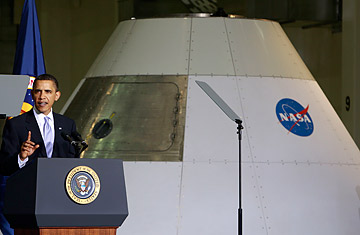
President Barack Obama attends the Space Conference at Cape Canaveral, Fla., on April 15, 2010
(2 of 2)
But it was the substance of the President's speech, not the visuals, that counted. Here he excelled as he often does at making a strong and exhaustively well-reasoned case for his plans; he clearly did his homework and seems honestly to believe in the direction he has chosen. But in the end, he may have succeeded only in applying very, very pretty lipstick to what remains, alas, a pig.
The problems with Obama's policies are numerous and represent a fundamental misreading of space history. His justification for killing the Ares booster — after $9 billion in development costs — was that the entire program was "behind schedule and over budget." That is entirely true, and it puts Ares in the company of virtually every spacecraft the U.S. has ever built and ever will build as long as NASA continues to use the competitive-bidding model in picking its contractors — a model that actually works quite well, but does ensure early lowballing from companies in order to win jobs.
The President also stressed that the idea of privatizing the design and construction of the space fleet is not so radical a plan, since NASA has always outsourced its work. That's true too — as far as it goes. But it was NASA designers who dreamed up the ships and determined the specs, then hired the firms that could deliver the goods — much the way you decide exactly the kind of house you want and choose the architect and builder who can give it to you. Under the new model, a scrum of competing architects will build what they want and force NASA to choose from what they offer.
The biggest historical flaw in the President's reasoning, however, is his belief that by essentially privatizing human space travel, "we can continue to ensure rigorous safety standards are met, but ... also accelerate the pace of innovations."
That's a sound industrial sentiment, and what it says about the bracing effect of competition is true, but it applies much less well to space travel — a uniquely complicated, uniquely dangerous enterprise that has never lent itself to economies of scale. The Apollo astronauts used to distinguish between engineering missions — those in which you're still testing and refining the machines — and operational missions, in which those worries are behind you and you can focus on why you're flying. Even after nine trips to the moon, the Apollo flights were all engineering missions, and even after 29 years of flying, so are the shuttles.
Assuming American astronauts do get off the ground sometime in the future, Obama, like Bolden, offered only a general idea of where they'll go. The space station will be flying at least until 2020, but once the shuttles are grounded — as the aging and too-dangerous ships must be — we won't be able to get there without hitching a ride on Russian Soyuz rockets at $50 million per seat.
Obama did declare firmly that there will be no return trip to the moon. "We've been there before," he said. "There's a lot more of space to explore." Of course, when you've landed at only six spots on the moon, all within hailing distance of the lunar equator, and the Apollo 11 exploration covered an area barely bigger than the infield of a baseball diamond, it's not too much to suggest there's a lot more of the moon still left to explore.
Near-earth asteroids and flybys of Mars are also a part of Obama's eventual long-term itinerary, as is a landing on Mars. While the Mars landing is probably a very remote goal, flyby missions and asteroid landings are actually a very good and surprisingly practical idea, since you avoid the deep gravity well that comes with landing on a large body like the moon or a planet — and that means being able to fly a much lighter, cheaper ship with much less fuel.
The best part of the President's plan — and, in fairness, the only one that really matters to many people trying to survive in a battered economy — is that it will preserve and create new jobs. New NASA funding for all of the programs Bolden specified back in February plus a planned upgrade of the Kennedy Space Center will mean new opportunities even as the end of the shuttle program eliminates others, and an expansion of the private rocket sector should create even more. Obama promised 2,500 new jobs along the space coast within two years and 10,000 within five years. Those may or may not come to pass, but a promised $40 million government investment in regional job-creation efforts certainly won't hurt.
For all this, the only thing that may not materialize is the whole actually-traveling-in-space part of the manned space program. For that, sadly, we may have to wait.
